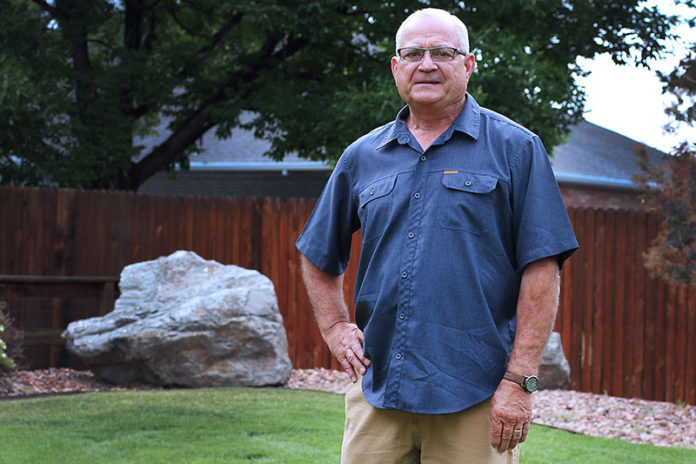The tiny thymus gland weighs only an ounce but punches much bigger than its weight as a crucial drill sergeant for the development of the human immune system.
It’s located behind the sternum and between your lungs, though it is only active until puberty.
“The thymus is a training center, or what I like to call the ‘barracks’ for the human body’s immune system,” said Dr. Hao Pan, a cardiothoracic surgeon at UCHealth in northern Colorado. “It trains t-cells to attack foreign invaders and around puberty, it shrinks and turns into a big glob of fat.”
But it didn’t go that way for Mike Oster, a Fort Collins retiree and avid fisherman. His thymus remained large. Scientists believe that when this happens, the gland may give incorrect instructions to developing immune cells, ultimately causing the immune system to attack its own cells and tissues and produce acetylcholine receptor antibodies – setting the stage for the attack on neuromuscular transmission, according to the National Institute of Neurological Disorders and Stroke.

For most of his life, Oster never had significant health issues. About five years ago, though, he noticed that he functioned well in the morning but as the day progressed, his muscles became weak and his body so tired he couldn’t make it out to fish or do the other things he enjoyed, like working in his yard. He noticed that a small cut would turn into an infection that would need medical intervention to resolve.
In December 2019, doctors diagnosed Oster with a neuromuscular condition called myasthenia gravis, a chronic autoimmune disease that leaves muscles — including those responsible for breathing — weak when they are not at rest.
Oster was prescribed a regimen of steroids and hormone medications to curb the symptoms of myasthenia gravis, but Oster did not like the way they made him feel, both mentally and physically.
Fortunately, medical advancements and research – closely followed by Dr. Pan — showed that removing the thymus, a surgery called a thymectomy, led to a significant reduction to no disease symptoms for 70% of adult patients.
Robotic thymectomy for myasthenia gravis

During his years of surgical training, Pan performed heart surgeries on infants and small children which gave him a thorough understanding of the function and maturation of the thymus. As Pan progressed into his professional career as an adult cardiothoracic surgeon, now with UCHealth Heart and Vascular Center, he often encounters the thymus in adult heart surgery.
“Myasthenia gravis is no longer a medical disease,” said Pan, the only doctor in northern Colorado performing robot-assisted thymectomy surgery. “It’s a surgical disease that is drastically minimized with decreased steroid use. And by using the robot (da Vinci Surgical System) to do the surgery, it’s an easily recoverable procedure.”

Preparing for a robotic thymectomy
Although there was a 1% chance of major bleeding, Oster agreed to the surgery. Using the da Vinci Surgical System for a thymectomy has many benefits, Pan said.
First, it eliminates the need to split the breastbone to reach the thymus. Because the gland is close to other vital organs, surgical removal requires refined skills and extensive dexterity. Pan uses his skills, with the assistance of the da Vinci Surgical System, to make three 5-millimeter ports on the right side of the chest and one on the left, making sure not to disturb the diaphragm.
“I was perfectly comfortable with Dr. Pan,” Oster said. “He was so confident — he knew what he could do. I wasn’t nervous at all.”
Oster’s surgery was scheduled for early March 2020, but then the pandemic hit and his surgery was postponed. Oster continued on the steroid and hormone pills and had surgery in June 2020.
.

Recovering from a thymectomy
The surgery took two hours.
“I spent three days in the hospital and then went home and mowed the lawn,” Oster said.

His wife, Phyllis, is thrilled with the results. “It’s made a big difference. He’s healthier, sleeps better and is more active.”

After the thymectomy, Oster addressed some of his other health issues. He spent the next year getting a “good tune-up,” he said. He had a colonoscopy, knee surgery and a procedure to tame his sleep apnea.
The couple took monthly road trips in the summer, taking their RV to some of Oster’s favorite mountain fishing spots. He also bought a paddleboard.
“I’ve always loved fishing. I grew up in the back of a boat or in the backwoods camping,” he said. “I gained a love for the outdoors, took up fly fishing about 30 years ago and got into tying flies and making my own rods, which I work on in the wintertime.
“To me, it’s very relaxing and an escape. You worry about the basics — do I have water and food — and not much else.”
That’s how retirement – and fishing — should be.
Credit: Source link































